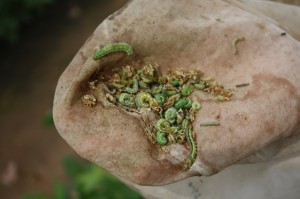Many calls continue to come in about various caterpillar species occurring in soybean in large numbers. These include corn earworm, yellowstriped armyworms and green cloverworms. This problem has mostly, but not exclusively, been in the counties bordering the Mississippi River. The problems have also tended to be worst in late planted fields. However, the bollworm flight has expanded and more areas are being affected. I hit on management in last week’s blog including suggested treatment thresholds and insecticide selection. There is not much more I can add. However, let me provide a few words of caution.
1) The majority of fields are free of serious pest infestations. Populations of the above pests are highly variable even in the worst areas. Some fields are loaded and others are mostly unaffected. It is VERY important to scout each field because differences in planting dates, maturity groups and other factors can have a major impact on pest populations.
2) A sweep net (or drop cloth) should be used to quantify pest populations. Seeing a “bunch” of worms is not a unit of measure.
3) Pest ID is critical and I touched on this last week. Seek professional help such as your local County Extension Agent if you do not know how to distinguish corn earworm, armyworms, green cloverworms and loopers. Finding an average of 10 corn earworms per 25 sweeps would justify an insecticide application in blooming soybeans, but it would not be close to threshold for armyworms or green cloverworm. You can’t just add them all together.
4) By all means, don’t delay treating if infestations are above the recommended treatment level. But don’t jump the gun! Just because a pest population is running one-half a threshold does not mean it will get worse. That is a good way to buy an extra and unnecessary insecticide application, and frankly, we don’t need to over-invest in some fields where yield potential is looking iffy.
On the upside, stink bug problems appear to be spotty at this time. Remember, stink bug numbers will often peak beginning R5 and especially in later maturing soybeans.


